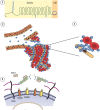Generation of a multi-functional, target organ-specific, anti-fibrotic molecule by molecular engineering of the extracellular matrix protein, decorin
- PMID: 29847688
- PMCID: PMC6284330
- DOI: 10.1111/bph.14374
Generation of a multi-functional, target organ-specific, anti-fibrotic molecule by molecular engineering of the extracellular matrix protein, decorin
Abstract
Extracellular matrix (ECM) molecules play important roles in regulating processes such as cell proliferation, migration, differentiation and survival. Decorin is a proteoglycan that binds to ('decorates') collagen fibrils in the ECM. Decorin also interacts with many growth factors and their receptors, the most notable of these interactions being its inhibitory activity on TGF-β, the growth factor responsible for fibrosis formation. We have generated a recombinant, multi-functional, fusion-protein consisting of decorin as a therapeutic domain and a vascular homing and cell-penetrating peptide as a targeting vehicle. This recombinant decorin (CAR-DCN) accumulates at the sites of the targeted disease at higher levels and, as a result, has substantially enhanced biological activity over native decorin. CAR-DCN is an example of how molecular engineering can give a compound the ability to seek out sites of disease and enhance its therapeutic potential. CAR-DCN will hopefully be used to treat severe human diseases. LINKED ARTICLES: This article is part of a themed section on Translating the Matrix. To view the other articles in this section visit http://onlinelibrary.wiley.com/doi/10.1111/bph.v176.1/issuetoc.
© 2018 The British Pharmacological Society.
Figures




References
Publication types
MeSH terms
Substances
LinkOut - more resources
Full Text Sources
Other Literature Sources
Miscellaneous

